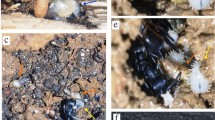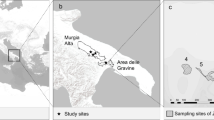Abstract
We present the results of a survey for natural enemies of eggs of the gypsy moth,Lymantria dispar (L.)(Lep.: Lymantriidae), in central Pennsylvania, along with a review of the world literature on the natural enemies of gypsy moth eggs. In Pennsylvania, the parasites wereOoencyrtus kuvanae (Howard)(Hym.: Encyrtidae) (by far the most abundant),Dibrachys cavus (Walker)(Hym.: Pteromalidae), andPediobius sp.(Hym.: Eulophidae). The predators were primarily ants(Hym.: Formicidae), but other predators included beetle larvae(Col.: Cantharidae, Dermestidae, Trogositidae), lacewing larvae(Neur.: Chrysopidae), bugs(Hem.: Pentatomidae), and mites(Acari). The parasiteO. kuvanae was in turn preyed upon by spiders(Araneida) and aPhymata sp.(Hem.: Phymatidae). Total predation of gypsy moth eggs averaged 11%, occurring at a constant rate of ca 0.6% per week throughout the summer and autumn. The greatest predation occurred nearer the ground with no differences among either aspect on the tree or tree species on which the egg mass was located. A negative association was discovered betweenO. kuvanae andD. cavus, but not betweenO. kuvanae andPediobius sp. Throughout the world, gypsy moth egg parasites and hyperparasites have been recorded from 6 different hymenopterous families; egg predators have been found in 13 families representing 5 orders of arthropods. Vertebrate predators of gypsy moth eggs are in 6 families of birds and 3 families of mammals.
Résumé
Nous présentons ici les résultats d'une enquête sur les ennemis naturels des œufs deLymantria dispar (L.)(Lep. Lymantriidae) dans la Pennsylvanie centrale, ainsi qu'une revue de la littérature sur les ennemis naturels des œufs deL. dispar. L'ennemi naturel le plus abondant estOoencyrtus kuvanae (Howard)(Hym. Encyrtidae); parmi les autres parasites en Pennsylvanie, on compteDibrachys cavus (Walker)(Hym. Pteromalidae) et une espèce dePediobius (Hym. Eulophidae). Les prédateurs des œufs sont principalement des fourmis(Hym. Formicidae), des larves de coléoptères(Col.: Cantharidae, Dermestidae, Trogositidae), des larves d'hémérobe(Neu. Chrysopidae), des punaises(Hem. Pentatomidae) et des acariens(Acari). Des araignées(Araneida) et une espèce dePhymata (Hem. Phymatidae) sont également prédateurs deO. kuwanae. La perte totale des œufs du disparate est en moyenne de 11%, selon un taux constant d'environ 0,6% par semaine pendant l'été et l'automne, la prédation la plus importante a lieu près du sol, sans qu'il y ait de relation avec l'orientation des œufs sur l'arbre, ou l'espèce d'arbre sur lequel se trouvent les œufs. Une association négative a été découverte entreO. kuwanae etD. cavus, mais pas entreo. kuwanae etPediobius.
Dans le monde les parasites d'œufs deL. dispar et les hyperparasites ont été signalés de 6 familles d'hyménoptères, les prédateurs d'œufs ont été trouvés dans 13 familles de 5 ordres d'arthropodes. Les vertébrés prédateurs des œufs appartiennent à 6 familles d'oiseaux et 3 familles de mammifères.
Similar content being viewed by others
References
Beeta Neves, C.M., Azevedo, F. &Silva, E. — 1944. Notes on the application of biological control in the campaign againstLymantria. —Bol. Junta Nac. Cortica (Lisboa), 63, 101–103. [Abstr. inRev. Appl. Entomol. (A) 337–310.]
Bess, H.A. — 1961. Population ecology of the gypsy mothPorthetria dispar (L.)[Lepidoptera: Lymantriidae]. —Conn. Agric. Exp. Stn. Bull., 646, 43 pp.
Bjegovic, P. — 1963a. Laboratory test of the reduction capacity, and some biological characteristics of the egg parasites of the gypsy moth. —Arh. Poljo Privredne Nauke, 16, 53–58. [Abstr. inBiol. Abstr., 47, 34616.]
— — 1963b. Competition betweenOoencyrtus kuwanai How. andAnastatus disparis R —Zast. Bilja, 14, 543–552. (Transl. from Serbo-Croatian).
Brown, M.W. — 1981. Population dynamics of the gypsy moth egg parasite,Ooencyrtus kuvanae (Howard)[Hymenoptera: Encyrtidae]. — Ph.D. Diss., The Graduate School of the Pennsylvania State University, XV + 165 pp.
Brown, M.W. &Cameron, E.A. — 1979. Effects of disparlure and egg mass size on parasitism by the gypsy moth egg parasite,Ooencyrtus kuwanai. —Environ. Entomol., 8, 77–80.
Brown, M.W., Rosenberger, J.L. &Cameron, E.A. — 1981. Development and evaluation of a sampling scheme for the gypsy moth egg parasitoid,Ooencyrtus kuvanae [Hymenoptera: Encyrtidae]. —Can. Entomol., 113, 575–584.
Campbell, R.W. — 1967. The analysis of numerical change in gypsy moth populations. —For. Sci. Monogr., 15, 1–33.
Campbell, R.W. — 1969. Studies on gypsy moth population dynamics. In: Forest Insect Population Dynamics. Proc., Forest Insect Population Dynamics Workshop, 1967. —U.S. Dep. Agric. Res. Pap. NE-125, 29–34.
Crossman, S.S. — 1925. Two imported egg parasites of the gipsy moth,Anastatus bifasciatus Fonsc. andSchedius kuwanae Howard. —J. Agric. Res., 30, 643–675.
DeLépiney, J. — 1927. Les insectes nuisibles du chêne liège dans la forêt de la Mamora (Maroc). —Ann. Epiphyt., 13, 145–174. [Abstr. inRev. Appl. Entomol. (A) 16, 314.).
— — 1929. Les insectes nuisibles du chêne liège dans la forêt de la Mamora (Maroc), deuxième étude. —Ann. Epiphyt., 14, 313–321. [Abstr. inRev. Appl. Entomol. (A), 16, 314.).
— — 1930. Contribution à l'étude du complexe biologique deLymantria dispar. —Mem. Soc. Sci. Nat. Maroc. 23, 1–100. [Abstr. inRev. Appl. Entomol. (A), 18, 569.]
— — 1933. Le rôle de la Direction des eaux et forêts du Maroc et de l'Institut Scientifique Chérifien dans la lutte biologique entreprise contreLymantria dispar à l'aide deSchedius kuwanai. —Congr. Int. Entomol. Paris, 1932, 5, 807–812. [Abstr. inRev. Appl. Entomol. (A), 22, 196.]
Dobrivojevic, K. — 1963. Some observations on the mass occurrence of gypsy moth in the district of Valjevo from 1947–1961. —Zast. Bilja, 14, 677–692. [Abstr. inR.W. Campbell, L.C. Levitan, E.R. Sobecki & M.F. Tardiff — 1978. Population dynamics of the gypsy moth: An annotated bibliography. —U.S. Dep. Agric. For. Serv. General Tech. Rep. NE-48, p. 38.]
Dowden, P.B. — 1961. The gypsy moth egg parasite,Ooencyrtus kuwanai, in southern Connecticut in 1960. —J. Econ. Entomol., 54, 876–878.
Dunbar, D.M., Weseloh, R.M. &Walton, G.S. — 1972. A fungus observed on egg clusters of the gypsy moth,Porthetria dispar. —Ann. Entomol. Soc. Am., 65, 1419–1421.
Forbush, E.H. &Fernald, C.H. — 1896. The Gypsy Moth:Porthetria dispar (Linn.). —Wright & Potter Printing Co. Boston. 495 pp.
Hérard, F. — 1979. Action des ennemis naturels deLymantria dispar [Lepidoptera: Lymantriidae] en forêt de Mamora (Maroc). —Entomophaga, 24, 164–175. (In French, English summary).
Hérard, F. &Fraval, A. — 1980. La répartition et les ennemis naturels deLymantria dispar (L.)[Lep.: Lymantriidae] au Maroc, 1973–1975. —Acta Oecol. Appl., 1, 35–48.
Howard, L.O. — 1970. Technical results from the gipsy moth parasite laboratory. I. The parasites reared or supposed to have been reared from the eggs of the gipsy moth. —U.S. Dep. Agric. Tech. Ser. Bull., 19, 1–12.
Howard, L.O. & Fiske, W.F. — 1911. The importation into the United States of the parasites of the gipsy moth and the brown-tail moth: A report of progress with some consideration of previous and concurrent efforts of this kind. —U.S. Dep. Agric. Bur. Entomol. Bull., 91.
Ishii, T. — 1928. TheEncyrtinae of Japan. —Bull. Imp. Agric. Exp. Stn. Japan., 3, 79–160. [Abstr. inRev. Appl. Entomol. (A), 20, 458.]
Kondakov, Y.P. — 1961. Distribution of egg clusters of the gipsy moth in forests of the southern part of the Krasnoyar region. —Uch. Zap. Krasnodar. Gos. Pedagog. Inst. Im. Trionadtsati-Letiza VLKSM, 20, 17–32. [Abstr. inR.W. Campbell, L.C. Levitan, E.R. Sobecki & M.F. Tardiff. — 1978. Population dynamics of the gypsy moth: An annotated bibliography. —U.S. Dep. Agric. For. Serv. Tech. Rep. NE-48, p. 65.]
Kurir, A. — 1944.Anastatus disparis Ruschka egg parasite ofLymantria dispar L. —Z. Angew. Entomol. 30, 551–586, [Abstr. inRev. Appl. Entomol. (A), 36, 116.]
Lee, H.P. — 1980. Egg parasitoids parasitizing gypsy moth (Porthetria dispar) in Korea. —16th Int. Congr. Entomol. Kyoto, Japan, Abstr. 3R-3, 9. p. 295.
Masner, L. — 1958. A new egg parasite of gipsy moth,Lymanthria dispar (L.). —Entomophaga, 3, 39–44.
Mercet, R.G. — 1918. Parasites ofPorthetria dispar (gypsy moth) in Spain. —Revista de Montes, Madrid, 42, 775–781. [Abstr. inRev. Appl. Entomol. (A), 7, 229.]
— — 1926. A new parasite ofPorthetria dispar. —Rev. Fitopatol., 2–3, 48–50 [Abstr. inRev. Appl. Entomol. (A), 14, 374.]
Mokrzecki, Z. &Ogloblin, A.A. — 1931.Hadronotus howardi n. sp. [Microhymenoptera:Proctotrupidae]. —Pl. pismo. Entomol., 10, 1–8 [Abstr. inRev. Appl. Entomol. (A), 19, 406.]
Nonveiller, G. — 1959. Predators of gypsy moth eggs found in Yugoslavia during the 1945–1950 gypsy moth plague. —Zast. Bilja, 10, 15–35. (Transl. from French).
Parker, D.L. — 1933. The interrelations of two hymenopterous egg parasites of the gypsy moth, with notes on the larval instars of each. —J. Agric. Res., 46, 23–34.
Pîrvescu, D. — 1978. Développement des gradations deLymantria dispar dans les peuplements de robinier de l'inspectorat forestier Dolj. —Zast. Bilja, 29, 151–154.
Prota, R., — 1966. Contributi alla conoscenza dell'entomofauna della quercio da sughero (Quercus suber L.). V. Osservazioni condotte in Sardegna suOoencyrtus kuwanai (Howard)[Hymenoptera: Encyrtidae] nuovo per la fauna italiana. —Stazione Sper. Sughero, Tempio Pausania. Memoria 17, 26 pp. (Italian with English summary).
Schaefer, P.W. — 1980. Natural enemies of gipsy moth (Lymantria dispar) in Japan and Korea, especially new and potentially useful species. —16th Int. Congr. Entomol. Kyoto, Japan. Abstr. 9P, 2, p. 297.
Smiley, D. — 1971. Gypsy moths and man: A story of mutual accommodation. —John Burroughs Nat. Hist. Soc. The Chirp, 18, 1–8. [Abstr. inR.W. Campbell, L.C. Levitan, E.R. Sobecki & M.F. Tardiff. — 1978. Population dynamics of the gypsy moth: An annotated bibliography. —U.S. Dep. Agric. For. Serv. Tech. Rep. NE-48, p. 106.]
Stefanov, D. &Keremidchiev, M. — 1961. The possibility of using some predators and parasitic insects in the biological control of the gipsy moth (Lymantria dispar L.) in Bulgaria. —Nauk. Trud. Vis. Lesctekj. Inst., 9, 157–168. [Abstr. inRev. Appl. Entomol. (A), 53, 170.]
Tadic, M.D. &Bincev, B. — 1959.Ooencyrtus kuwanai How. in Yugoslavia. —Zast. Bilja, 10, 51–59 (Transl. from Serbo-Croatian).
Templado, J. — 1957. Data onOoencyrtus kuwanai, a chalcid parasite onLymantria dispar L., in Spain. —Publ. Inst. Biol. Aplicada, 25, 119–129. [Abstr. inRev. Appl. Entomol. (A), 46, 294.]
Weseloh, R.M., Wallner, W.E. &Hoy, M.J. — 1979. Possible deleterious effects of releasingAnastatus kashmirensis, a facultative hyperparasite of the gypsy moth. —Environ. Entomol., 8, 174–177.
Author information
Authors and Affiliations
Additional information
This work was supported under Regional Project NE-84 (revised), “Behavior and Interrelationships of the Gypsy Moth, its Natural'Enemies and Insecticides”, and conducted under Experiment Station Project No. 2044. Authorized for publication as paper no. 6306 in the Journal Series of the Pennsylvania Agricultural Experiment Station.
Rights and permissions
About this article
Cite this article
Brown, M.W., Cameron, E.A. Natural enemies ofLymantria dispar [Lep.: Lymantriidae] eggs in Central Pennsylvania, U.S.A., and a review of the world literature on natural enemies ofL. dispar eggs. Entomophaga 27, 311–321 (1982). https://doi.org/10.1007/BF02374814
Issue Date:
DOI: https://doi.org/10.1007/BF02374814




